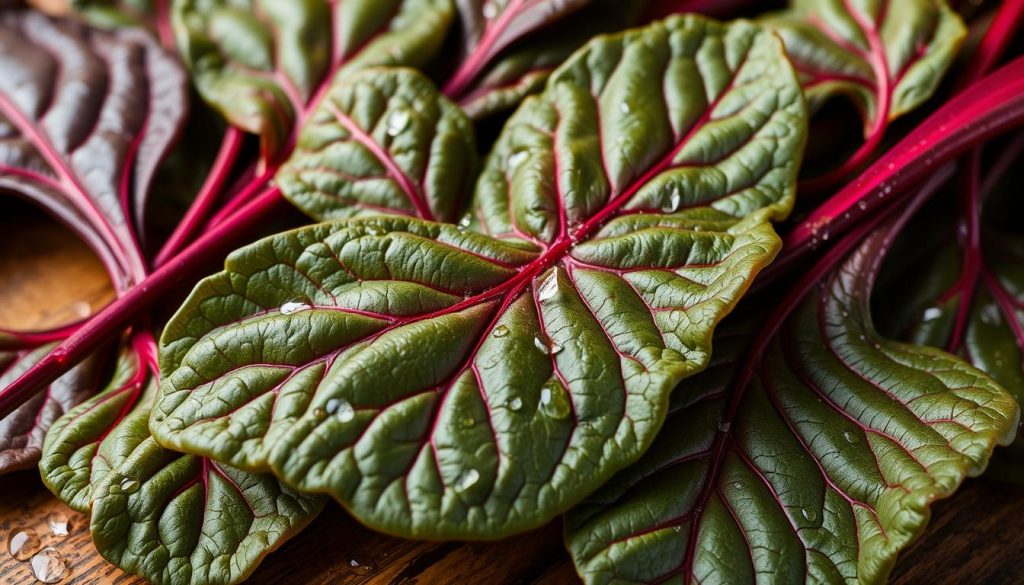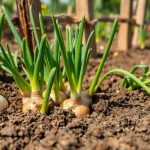Did you know that just one cup of raw beetroot leaves has 127% of your Daily Value of Vitamin K? This green is full of *nutritional advantages* that can boost your health. It helps your immune system and keeps your heart healthy. Adding beetroot leaves to your meals brings variety and lots of vitamins and minerals.
Key Takeaways
- Beetroot leaves are rich in vitamins and minerals, making them a healthy addition to meals.
- A single cup offers more than a full day’s requirement for Vitamin K.
- These greens provide essential nutrients like calcium and potassium.
- Growing beetroot leaves is simple with optimal conditions and proper care.
- Cooking methods can enhance the retention of their nutrients effectively.
- Beetroot leaves can be dehydrated for long-term storage and versatility in recipes.
Introduction to Beetroot Leaves
Beetroot leaves, also known as beet greens, are a wonderful addition to both gardens and kitchens. These nutrient-rich greens bring a mix of flavours and textures. They are perfect for many dishes, from salads to soups. I love how they add a sweet taste and make cooking fun.
Recently, chefs and home cooks have started to love beetroot leaves again. They see the health benefits and want to include them in meals. The leaves’ bright colours and soft texture make dishes look and taste great. They add nutrients that help us stay healthy.
Beetroot leaves have a long history in cooking. In Victorian Britain, they were used in many recipes. I enjoy trying out new recipes with beet greens. They can turn a simple dish into something special. Whether raw in salads or cooked with garlic and olive oil, they always impress.
Can you Eat Beetroot Leaves
Eating beetroot leaves is a delightful experience. They are packed with flavour and nutrients. I use them like spinach or Swiss chard in many dishes.
The taste of beet greens is sweet and enhances meals. They add colour and vibrancy to my dishes. Raw leaves are great in salads for a fresh crunch. Cooked leaves, 4 inches or more, are tender and soft.
I love making a simple dish with olive oil, garlic, sea salt, black pepper, and lemon juice. It brings out the best in beet greens. The whole leaf, including stems, is used, reducing waste and boosting nutrition.
For those new to beet greens, try different recipes. They’re full of antioxidants and are as healthy as kale. Adding them to meals is a creative and healthy choice.
Health Benefits of Beetroot Leaves
Beetroot leaves are packed with health benefits, boosting your overall well-being. They are full of nutrients that help your body function well. Adding them to your diet is a smart choice.
Rich in Nutrients
These leafy greens are a treasure trove of vitamins and minerals. They are rich in Vitamin A, which is great for your eyes. They also have Vitamin C, which fights off harmful free radicals.
Beetroot leaves have more calcium and iron than many other greens. This means they help strengthen your bones and improve your blood health. Just one cup gives you over 100% of Vitamin K and nearly 60% of Vitamin C.
Support Immune Function
Beetroot leaves are full of antioxidants that support your immune system. These antioxidants fight off oxidative stress and boost your body’s defence. Eating beet leaves can make you less likely to get sick.
Cardiovascular Health Benefits
Beetroot leaves are good for your heart. They are full of nitrates that can lower blood pressure and improve blood flow. This is great for people who are active.
Good blood flow means your muscles get more oxygen. This helps you stay strong and energetic. Adding beet leaves to your meals or smoothies can help keep your heart healthy.
Nutrition Facts of Beetroot Leaves
Beetroot leaves are a nutritional powerhouse. They are full of vitamins and minerals, making them great for your diet. Their vibrant colour and strong flavour add to their nutritional value.
Vitamins and Minerals
Beetroot leaves are rich in essential vitamins and minerals. Here’s what you get from 100 grams:
- 211% of the Recommended Daily Allowance (RDA) of Vitamin A
- 50% of the RDA of Vitamin C
- 333% of the RDA of Vitamin K
- 32% of the RDA of Iron
- 21% of the RDA of Copper
They also have Calcium, Sodium, Potassium, and Magnesium. Plus, they’re packed with B-complex vitamins like Riboflavin and Folate. These nutrients boost your health and energy.
Caloric Content
Beetroot leaves are low in calories, with just 22 calories per 100 grams. They’re perfect for those watching their weight but need to stay nourished.
Comparison with Other Greens
Compared to spinach, beetroot leaves have more iron. This is great for boosting iron levels. Here’s a comparison table:
| Green | Calories (per 100g) | Iron (% RDA) | Vitamin K (% RDA) |
|---|---|---|---|
| Beetroot Leaves | 22 | 32 | 333 |
| Spinach | 23 | 15 | 460 |
| Kale | 35 | 14 | 684 |
Beetroot leaves are a nutritious, low-calorie food. They can be easily added to many dishes for extra flavour and health benefits.
Growing Tips for Beetroot Leaves
Growing beetroot leaves is rewarding. They do well in many conditions and are full of nutrients. Knowing the best conditions and how to harvest them will help you grow them successfully.
✅ Check the price on Amazon for Beetroot seeds
Optimal Growing Conditions
Beetroot leaves need the right environment to grow well. They love well-draining soil with a slightly acidic to neutral pH. I sow seeds when it’s around 16°C (50°F).
I plant seeds 2.5cm (1in) deep, 30cm (1ft) apart in rows. Outdoors, seeds should be 10cm (4in) apart or in groups of 15cm (6in).
It’s important to water them regularly, more so in dry weather. I water every 10-14 days to keep the roots healthy. Thinning seedlings to 10cm (4in) apart helps them grow bigger.
Harvesting Techniques
Beetroot leaves can be picked several times. I pick the outer leaves first, letting the inner ones grow. This way, I get more leaves for longer.
Keeping four or five leaves on each plant encourages more growth. Beetroot is ready in 40 to 60 days.
Beetroots can be picked at different stages. Young ones are like golf balls, while mature ones are like cricket balls. Regular weeding helps them grow better.
| Aspects | Details |
|---|---|
| Optimal Temperature | 16°C (50°F) |
| Sowing Depth | 2.5cm (1in) |
| Row Spacing | 30cm (1ft) |
| Seed Spacing (Outdoors) | 10cm (4in) or 15cm (6in) |
| Weeding Frequency | Regular (by hand) |
| Watering Frequency | Every 10-14 days during dry spells |
| Harvest Timing | 40 – 60 days after sowing |
Cooking Tips for Beetroot Leaves
Adding beetroot leaves to my meals is a great way to enjoy their strong taste and health benefits. With a few simple tips, these greens can become the main attraction. It’s important to cook them in a way that keeps their nutrients intact.
Best Methods for Retaining Nutrients
Steaming beetroot leaves is the best way to keep their nutrients. It helps prevent the loss of vitamins that are sensitive to heat. I also like to sauté them with garlic or onion. This method boosts their flavour and keeps most of their nutrients.
✅ See the price of Steamers on Amazon
Pairing with Other Ingredients
Choosing the right ingredients to pair with beetroot leaves can make them even more delicious. They go well with:
- Citrus – A bit of lemon or orange juice adds a nice zing.
- Feta cheese – Its creaminess complements the earthy taste of the leaves.
- Various nuts – Walnuts or pine nuts add a nice crunch.
Trying out these combinations can turn beetroot leaves into a tasty main dish or a great side. With these tips and pairings, I can discover new recipes to enjoy.
Challenges When Using Beetroot Leaves
Beetroot leaves are great in many dishes, but they come with some challenges. They can cause allergies in some people and need special care to stay fresh.
Potential Allergies and Side Effects
Some might get allergies from beetroot leaves, like those who are sensitive to celery. It’s key to watch out for any bad reactions when you first try them. Also, eating too much can cause headaches or stomach problems because of their high nitrate levels. Start with small amounts to see if you’re allergic.
Storage and Freshness Tips
Storing beetroot leaves right is important to keep them fresh. I wrap them in a damp paper towel and put them in a plastic bag. This keeps them moist and fresh for days in the fridge. Keep them away from air and moisture to stop them from wilting or going bad.
| Storage Method | Effectiveness |
|---|---|
| Damp paper towel in a bag | High |
| Plastic container | Medium |
| Directly in fridge | Low |
Knowing about these challenges helps me enjoy beetroot leaves safely. I can avoid allergies and keep them fresh for cooking.
Conclusion
Adding beetroot leaves to my meals has many health benefits. They not only make my food taste better but also improve my health. These greens are full of nutrients that help my immune system, heart health, and antioxidants.
Beetroot leaves are great in cooking because they’re both tasty and healthy. I can sauté them, blend them into smoothies, or add them to salads. Their unique flavour makes any dish better. By using them, I make my diet more interesting and nutritious.
Using beetroot leaves in my cooking makes my meals more varied and healthy. Learning about their benefits and how to cook them helps me eat well. It’s a win-win for my taste buds and my health.
Don’t Stop there!
Discover loads more Information about growing Cauliflowers, Visit the Beetroot > Home page
- Check the price on Amazon for Beetroot seeds
- 🔥 Follow My YouTube Channel for guidance along the season or just pop in and say Hi
- Product links from Amazon please see our Privacy Policy for more details
Back To Home Page
Want More Information?
Here are some other guides from the Web to give you a complete understanding of Beetroot from different sources.
- Beet Greens Benefits, Nutrition Facts, And Side Effects
- Beetroot – good for salads & many other dishes
- How to Dehydrate Beet Leaves — The Purposeful You · Garden + Sustainable Living
- Beetroot
- No title found
- Waste Not… How To Make Your Beetroot Leaves Into a Delicious Dip – Tom’s Feast
- Sautéed Beet Greens – Love and Lemons
- How to Cook Beet Greens
- 15 Ways to Eat Beet Greens (And Why You Should)
- What To Do With Beetroot Leaves and Stalks
- 10 Incredible Health Benefits of Beet Greens — Just Beet It
- Beetroot nutritional info, health benefits, recipes & more
- 11 Impressive Beet Greens Nutrition Facts and Health Benefits
- Beetroot 101: Nutrition Facts and Health Benefits
- Beetroot
- Perfect Beetroot Every Time
- Beetroot Leaves Poriyal | Beet Greens Stir Fry
- Beetroot leaf tart
- BEET: Overview, Uses, Side Effects, Precautions, Interactions, Dosing and Reviews
- 9 beetroot growing mistakes to avoid if you want to eat the best beets
- Beet Stalks and Leaves (Beta vulgaris L.) Protect Against High-Fat Diet-Induced Oxidative Damage in the Liver in Mice
- Leaves of White Beetroot As a New Source of Antioxidant and Anti-Inflammatory Compounds


